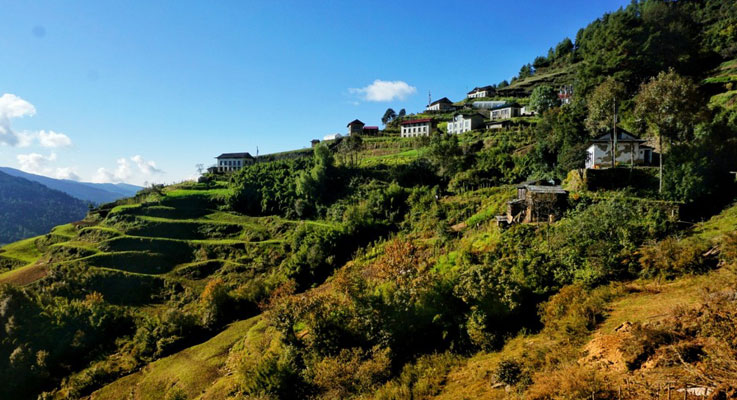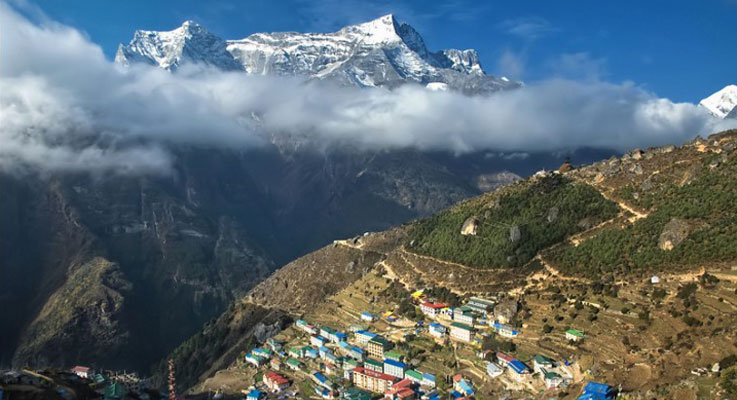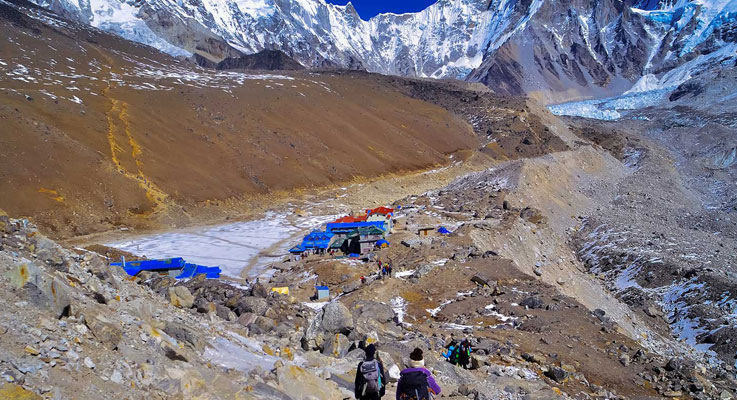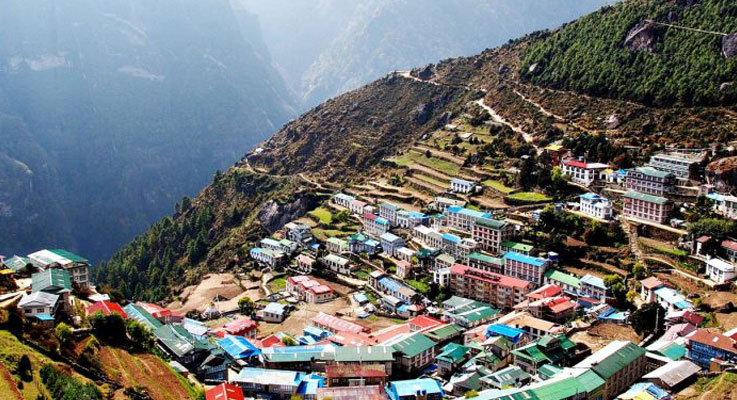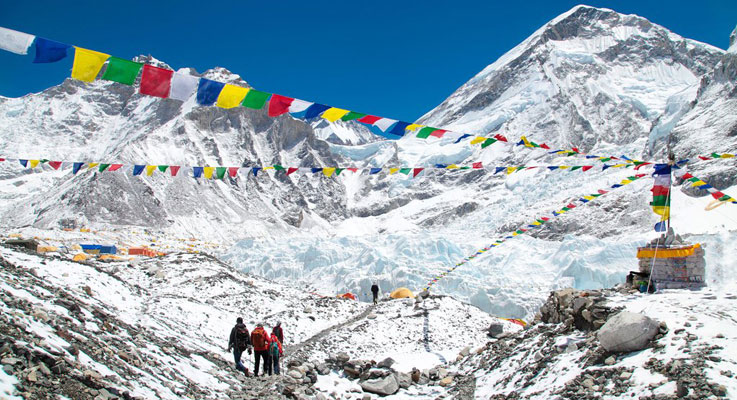-
Day 1
Arrival in Kathmandu
Upon arriving at at Tribhuwan International Airport in Kathmandu, you will be received by our airport representatives who will warmly greet you and transfer to the hotel on a private tourist vehicle. We provide 3-star accommodation in the city and we arrange for a trip briefing with dinner in the evening.
-
Day 2
Visit old town of Kathmandu
A professional guide and vehicle are provided for a day of sightseeing in and around Kathmandu city. We visit some of the UNESCO World Heritage Sites in the city along with other interesting cultural monuments that dot the valley. These include Boudhanath Stupa (the largest Buddhist shrines in the world), Pashupatinath (the holiest Hindu temple in the world), Durbar Squares (Palaces and fortresses of medieval Kings), along with other popular cultural attractions. We get to observe the lifestyle of Nepalese people, holy sadhus and monks, fascinating history as well as awe-inspiring architecture.
-
Day 3
Drive from Kathmandu to Jiri
Early morning drive along the Tibetan border road to Lamasangu. Turn off onto the road beginning built to Jiri. The road twists and turns its way through Tamang and Chhetri villages via Charikot to Jiri. 7 – 8 hrs drive.
-
Day 4
Trek from Jiri to Bhandar
We trek through different villages to Sibalaya. From Sibalaya gradual climb to Deurali(2710m) Pass and then descend to Bhandar (Changma(2190m))
-
Day 5
Trek from Bhandar to Sete
Descend from the pass to the Sherpa village of Bhandar. Descend to cross a wooden bridge and then descend to follow the LikhuKhola. Cross-via a suspension bridge and continue to Kenja (1630m). Ascend to Sete.
-
Day 6
Trek from Sete to Junbesi
Begin the long but fairly gradual climb to the Lamjura pass (3530m). There are fine views from the pass (if weather permits). The trail now descends through pine forest to the settlement of Thagdobuk and then to Junbesi (2675m), an attractive Sherpa village situated amidst beautiful surroundings.
-
Day 7
Trek from Junbesi to Thaksindu
Cross the river and take the left hand upper trail to the Salung ridge. First view of Everest from here, also views of Thamserku (6,623m) and Kusum Kangaru (6,369m). Descend to Ringmo Khola and gradual climb upto Traksindo Pass (3,200m). A few minutes below the pass on the east side is Traksindo Monastery. We will have a outstanding sun set/sun rise and mountain views from here.
-
Day 8
Trek from Thaksindu to Kharikhola
The trail descends through forest pass Nunthale and Rai villages, fields cross DudhKoshi river and trek through Rai village of Jubing to Kharikhola.
-
Day 9
Trek from Kharikhola to Payang
The trail descends from the village, crosses a stream beside water driven mills, then ascends to pass Kharte (2830m), and then through forest on lower trail to Payang.
-
Day 10
Trek from Payang to Phakding
Follow the trail down to Surkhe on a tributary of the Dudh Koshi. Ascend to our lunch-spot at Mushey (2,500m). Pass through villages of Choplung and Ghat (2,550m) to Phakding.
-
Day 11
Trek from Phakding to Namche Bazaar
Walking along the shores of Dudh Kosi, we get to cross the serene river many times on exhilarating suspension bridges decorated with prayer flags. A little further, we enter Sagarmatha National Park from where the trail climbs steeply with picturesque sights. After trekking for a few hours, we reach Namche Bazaar, known as the Gateway of Everest.
-
Day 12
Namche Bazaar acclimatization day
In order to acclimatize to the altitude gained and thinner air, we spend a day in Namche Bazaar. There are several quality restaurants, hotels, lodges, shops, money exchange services, internet cafes and bakeries at this town, also the largest in the Everest region. We pay a visit to the museum nearby known for its traditional artefacts that showcase the Sherpa culture. We also hike to Syangboche Airport from where we can see rewarding vistas of stunning sunrise and sunset over the Himalayan panorama.
-
Day 13
Namche Bazaar to Deboche
We ascend out of the village and follow a high, fairly level path above the Dudh Koshi enjoying spectacular mountain views of Everest, Nuptse and Lhotse as we go. We pass the various ‘shops’ set up by Tibetans selling trinkets and then descend through forest of blue pine to cross the Dudh Kosi again at Phunki (3,250m). We make another ascent on a switch-back trail, sometimes made quite dusty by yak trains, to reach the spectacularly sited Thyangboche Monastery (3,867m) from where there are brilliant views of Everest, Lhotse, Nuptse, Ama Dablam and Taboche to the north and northeast, Thamserku and Kantega to the southeast and Kwangde to the southwest. Thyangboche Monastery was seriously damaged by fire in 1989 but has since been rebuilt and there will be time to visit both the monastery and the museum. We reach our teahouse at Deboche.
-
Day 14
Trek from Deboche to Dingboche
We descend through meadows and rhododendron forest, past the Buddhist nunnery at Deboche, to the Imja Khola. Then up along the north bank of the river, with spectacular views of AmaDablam, to a teahouse at Orsho. Crossing the confluence of the Khumbu and Imja Kholas we continue to Dingboche (4,410m).
-
Day 15
Trek from Dingboche to Lobuche
We are now well above the tree line and our walking today takes us across a wide plateau to Dusa, from where we descend and cross a fast flowing stream, before continuing the short distance up to the teahouse at Dughla (4,620m). From here we then continue up the dominating ridge that lies before us, where we find a number of memorials to Sherpas killed on the various expeditions up Everest. Continuing along the moraine of the Khumbu Glacier, taking in the views of Kala Pattar and Pumori as we go, we finally reach Lobuche (4,930m) and the end of our day’s trek.
-
Day 16
Trek from Lobuche to Gorakshep. Climb to the summit of Kala Pattar
It’s worthwhile making an early start today, to ensure the best chance of good views. Initially following a fairly level trail, we then begin a series of ascents and descents that crosses moraine landscapes to the small settlement of Gorakshep (5160m). From here we make a steep and fairly gruelling ascent up the nearby peak of Kala Pattar, whose summit (5545m) affords some quite breathtaking views of Base Camp, the summit of Everest and the South Col. There is little that can prepare you for the sheer magnificence of this landscape, with the towering heights of Everest to the east and the entire range of Lhotse, Nuptse, Pumori and Taboche laid out in all their glory before us. Descending from here we head back to Gorak Shep for the night. Total walking: Approx 9 hours. Ascent/descent 615m.
-
Day 17
Trek from Gorkshep to Everest Base Camp, then to Pheriche
Another early start this morning sees us following the moraine peppered Khumbu Glacier towards Everest Base Camp and the imposing face of the Khumbu Icefall. Whilst the views along this stretch of the valley aren’t as spectacular as yesterday’s climb up Kala Pattar (you can’t actually see the peak of Everest along this route) the journey is still fascinating.
It affords us the chance to view towering pinnacles of ice, called seracs, which are a particular feature of the Himalayan glaciers. Reaching up to 15 metres in height, these pillars of ice present an ever-present danger to mountaineers, as they can collapse without warning and, indeed, the Khumbu Icefall is considered one of the most dangerous sections of the South Col route up to Everest’s summit. Retracing our steps from here we then head back to Dughla, re-crossing the waters of the Khumbu Khola and descending to the valley of Pheriche, where there is every chance of coming across yak grazing amongst the pastures.
-
Day 18
Trek to Pangboche and then onto Phortse
After crossing over a small pass, we then follow the trail through the Imja Khola Valley this morning, before ascending towards the old village of Pangboche (3,985m). On arrival we walk up to the ancient monastery that is situated above the village, a structure that is reputed to be over 300 years old. Said to have been built over the site of the original hermitage of the Lama Sanga Dorje, legend has it that the juniper trees that surround the monastery grew from the hair on the saint’s head. From here we then follow a little used track that leads on to the village of Phortse (3,840m), perched above the confluence of the Dudh Kosi and the Imja Khola Valley. Besides the spectacular mountain views that assail us from every side, there is also a possibility today of sighting Himalayan thar on the steep slopes.
-
Day 19
Trek from Phortse to Monzo
Descend to Phortse Tenga and ascend to Moangchorten (3,992m). Drop down again to Sanasa and return by a different trail to Namche Bazaar via the Everest View Hotel and Shyangboche airstrip or via Khunde and the Hillary hospital then descend and exit the National Park to overnight at Monzo 2840m.
-
Day 20
Trek from Monzo to Lukla
Continue to retrace the route along the Dudh Kosi and make a final ascent to reach Lukla (2,840m).
-
Day 21
Morning flight back to Kathmandu
Today we fly back to Kathmandu from Lukla, and during your flight you can enjoy some last-minute glimpses of the mountains. Upon arrival in Kathmandu, you can rest, relax and go sightseeing throughout the day.
-
Day 22
Leisure day in Kathmandu
This is a leisure and free day in Kathmandu for exploration. You are free to go souvenir shopping, spa and more exploration of the city, or extend your trip to include bungee jumping, rafting, mountain biking, Everest mountain flight and other adventurous activities. In the evening, we will have a farewell dinner at Mul Chowk Restaurant’s cozy and elegant dining ambience.
-
Day 23
Departure from Nepal
The trip concludes today. You will be dropped at Kathmandu's Tribhuwan International Airport by our airport representative for your flight departure from Nepal.

